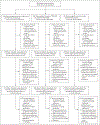A Placebo-Controlled Trial of Antibiotics for Smaller Skin Abscesses
- PMID: 28657870
- PMCID: PMC6886470
- DOI: 10.1056/NEJMoa1607033
A Placebo-Controlled Trial of Antibiotics for Smaller Skin Abscesses
Abstract
Background: Uncomplicated skin abscesses are common, yet the appropriate management of the condition in the era of community-associated methicillin-resistant Staphylococcus aureus (MRSA) is unclear.
Methods: We conducted a multicenter, prospective, double-blind trial involving outpatient adults and children. Patients were stratified according to the presence of a surgically drainable abscess, abscess size, the number of sites of skin infection, and the presence of nonpurulent cellulitis. Participants with a skin abscess 5 cm or smaller in diameter were enrolled. After abscess incision and drainage, participants were randomly assigned to receive clindamycin, trimethoprim-sulfamethoxazole (TMP-SMX), or placebo for 10 days. The primary outcome was clinical cure 7 to 10 days after the end of treatment.
Results: We enrolled 786 participants: 505 (64.2%) were adults and 281 (35.8%) were children. A total of 448 (57.0%) of the participants were male. S. aureus was isolated from 527 participants (67.0%), and MRSA was isolated from 388 (49.4%). Ten days after therapy in the intention-to-treat population, the cure rate among participants in the clindamycin group was similar to that in the TMP-SMX group (221 of 266 participants [83.1%] and 215 of 263 participants [81.7%], respectively; P=0.73), and the cure rate in each active-treatment group was higher than that in the placebo group (177 of 257 participants [68.9%], P<0.001 for both comparisons). The results in the population of patients who could be evaluated were similar. This beneficial effect was restricted to participants with S. aureus infection. Among the participants who were initially cured, new infections at 1 month of follow-up were less common in the clindamycin group (15 of 221, 6.8%) than in the TMP-SMX group (29 of 215 [13.5%], P=0.03) or the placebo group (22 of 177 [12.4%], P=0.06). Adverse events were more frequent with clindamycin (58 of 265 [21.9%]) than with TMP-SMX (29 of 261 [11.1%]) or placebo (32 of 255 [12.5%]); all adverse events resolved without sequelae. One participant who received TMP-SMX had a hypersensitivity reaction.
Conclusions: As compared with incision and drainage alone, clindamycin or TMP-SMX in conjunction with incision and drainage improves short-term outcomes in patients who have a simple abscess. This benefit must be weighed against the known side-effect profile of these antimicrobials. (Funded by the National Institutes of Health; ClinicalTrials.gov number, NCT00730028 .).
Figures

Comment in
-
Adjunctive antibiotics for drained skin abscesses improve clinical cure rate.Evid Based Med. 2017 Dec;22(6):214. doi: 10.1136/ebmed-2017-110815. Epub 2017 Oct 11. Evid Based Med. 2017. PMID: 29021202 No abstract available.
-
In small skin abscesses, clindamycin or trimethoprim-sulfamethoxazole after incision and drainage increased cures.Ann Intern Med. 2017 Oct 17;167(8):JC39. doi: 10.7326/ACPJC-2017-167-8-039. Ann Intern Med. 2017. PMID: 29049758 No abstract available.
-
A Trial of Antibiotics for Smaller Skin Abscesses.N Engl J Med. 2017 Dec 28;377(26):e36. doi: 10.1056/NEJMc1711124. N Engl J Med. 2017. PMID: 29281571 No abstract available.
-
A Trial of Antibiotics for Smaller Skin Abscesses.N Engl J Med. 2017 Dec 28;377(26):e36. doi: 10.1056/NEJMc1711124. N Engl J Med. 2017. PMID: 29282969 No abstract available.
-
A Trial of Antibiotics for Smaller Skin Abscesses.N Engl J Med. 2017 Dec 28;377(26):e36. doi: 10.1056/NEJMc1711124. N Engl J Med. 2017. PMID: 29282970 No abstract available.
-
Antibiotics Should Not Be Routinely Prescribed After Incision and Drainage of Uncomplicated Abscesses.Ann Emerg Med. 2019 Apr;73(4):377-378. doi: 10.1016/j.annemergmed.2018.04.026. Ann Emerg Med. 2019. PMID: 30902165 Free PMC article. No abstract available.
References
-
- Lipsky BA, Kollef MH, Miller LG, Sun X, Johannes RS, Tabak YP. Predicting bacteremia among patients hospitalized for skin and skin-structure infections: derivation and validation of a risk score. Infect Control Hosp Epidemiol 2010; 31: 828–37. - PubMed
-
- Moran GJ, Krishnadasan A, Gorwitz RJ, et al. Methicillin-resistant S. aureus infections among patients in the emergency department. N Engl J Med 2006; 355: 666–74. - PubMed
-
- Liu C, Bayer A, Cosgrove SE, et al. Clinical practice guidelines by the Infectious Diseases Society of America for the treatment of methicillin-resistant Staphylococcus aureus infections in adults and children: executive summary. Clin Infect Dis 2011; 52:285–92. - PubMed
Publication types
MeSH terms
Substances
Associated data
Grants and funding
LinkOut - more resources
Full Text Sources
Other Literature Sources
Medical
Research Materials
